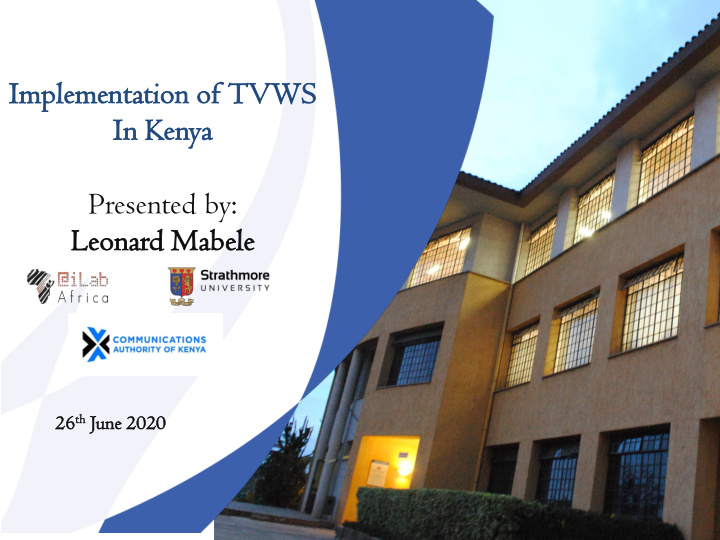



Impleme menta ntation tion of TVWS In Ken enya Presented by: Le Leonar ard d Mabel ele th June 26 26 th e 2020
TV White Spaces Opportunity in Kenya • A large percentage of the rural counties of Kenya is underserved in terms of Internet Access. Out of the 7 sub-counties in Kisumu county for instance, only 1 sub-county has a good Internet connection. • Kenya’s Vision 2030 and the Digital Economy Blueprint (unveiled in May 2019) is premised on ubiquitous provision of universal broadband access. • The rise of digital innovation, startup ecosystem and development of emerging technologies such as IoT demonstrates a “must” need for Wireless Internet access. • The UHF TV Band (470-694) allocated on a primary basis for broadcasting services has 28 channels of 8 MHz bandwidth (from CH 21 to CH 48) that are available for DTT broadcasting in Kenya. Not all these 28 channels are activated for transmission at each site due to technical and geographical variations. The channels that are not activated for DTV transmission in non-active locations can be dynamically exploited for TV White Spaces (TVWS) to provide Internet access.
TV White Spaces Journey in Kenya
TVWS Experiments in Kenya – Microsoft 2013 1. Microsoft 4Afrika Trial Authorisation 2013- 2014 in the vicinity of Nanyuki & Kalema Results: No interference to the incumbent DTV services. Point-to – multipoint coverage of up to 14km TVWS operated at 2.5W (EIRP Measurement). Approximately 235km 2 covered using multiple 90 degree base station sector antennas. Approximately 16 Mbps of speeds have been achieved on a single 8 MHz TV channel. Base station powered by solar energy. Video streaming, Emails, Video Conferencing and High Speed VPN services supported seamlessly.
TVWS Experiments in Kenya – GDB Test 2. TVWS Demonstration with Nominet Geolocation Database (GDB) and Adaptrum ACRS 2.0 Base Station Results: The Protocol to Access White Space (PAWS) database script implemented on the ACRS2 Base Station (BS). The Base station connected to the Nominet Database and could be viewed live. No GPS at the time. Manual coordinates used. List of available channels can be selected from the BS interface.
TVWS Experiments in Kenya – GDB Test 3. Embu Tests without a Geolocation Database (GDB) Results: 1 ACRS 2 Base Station and 5 ACRS 2 clients Capacity on the CPE station was 20 Mbps. No interference reported though implementation not managed by a GDB.
TVWS Experiments in Kenya – Mawingu 2020 4. 2020 Assessment Test of Mawingu Network’s TVWS with Fairspectrum Database Adaptrum B1000 Base Station and 4 ACRS2 Client Radios used. The client setup had 2 CPEs at Answer Plaza, 1 at Cape Chestnut and another at Bemwaki Plaza. The Base Station was at Cedar Mall. Cedar Mall Master WSD Installation The network setup with the B1000 base radio transmitted in a 120° sector and 3 clients each with a directional antenna of an antenna gain 11dB. The links operated in a TDD mode between the master WSD and client WSD in one 8 MHz BW channel. The model of radio installed did not allow for contiguous channels set up. No out of band emissions experienced.
TVWS Spectrum Monitoring – Kitui 2020 Studies in Kitui County Field measurements carried out for 2 weeks in February 2020 Some assigned channels were off-air adding to unused RF spectrum. A scan for all 28 DTT channels using 8 MHz channel separation in the 470-698 MHz band with a measurement time of 3 seconds carried out. The varying color codes in the spectrum coverage map indicate field strength levels as one moves away from the DTT transmitting locations. Figure below indicates signal strength map for DTT channel 21 Kitui County. there are nine (9) TV channels assigned for DVB-T in Kitui according to CA’s database. From the field survey, it was noted that only four of the assigned nine TV channels are active. However, in some areas the received field strength level was lover than the -85 dbm required for minimum TV reception. The terrain is rugged also hindering signal penetration leading to poor coverage. There are 24/28 available TV channels suitable for deployment of TV whitespace devices in Kitui County.
University-Regulator Collaboration • Strathmore University (SU) and the Communications Authority of Kenya (CA) signed an MoU in January 2019 (Stretching to 2022) to establish a framework of collaboration on spectrum management research. The research covers – Dynamic Spectrum Access (DSA) techniques, A focus on TV White Spaces, 5G, Software Defined Radio and Cognitive Radio techniques as well as Cybersecurity. • In December 2019, the UK Department for International Development (DFID) provided a grant to SU in collaboration with CA to complete the validation exercise for the TVWS draft framework whose work had began earlier on. The project officially began in January 2020 and is expected to end in August 2020. • Tracks on the project included:- Field surveys and studies in Kisumu, Kitui and Laikipia counties to validate theoetical measurements, new technical tests together with Dynamic Spectrum Alliance partners, In-country co-existence calculations between DTTs and WSDs and stakeholder engagements on the draft framework. The overall output of this work is the release of the TVWS framework for Kenya.
Kenya’s TVWS Framework Architecture Kenya has proposed to adopt the Lightly-licensed regulatory model
TVWS Potential, Limitations and Next Steps • TVWS Potential : Rural Wireless Internet Provision for Schools, Health Centres, Technical Institutions, Rural Startup hubs, County government offices and services etc. TVWS will also enable access to e-government services by rural populations. • Limitations : Guarantee on Return on Investment, Global feedback on the deployment of TVWS in other countries, challenges of local knowledge and technical skills for deployments. • Next Steps : SU and CA will be pursuing more studies on dynamic spectrum access - Mobile Networks (including 5G), WiFi 6 and other bands, research on Neutral hosting and pursue more work on SDRs/CRs which is still a key research block in our MoU for DSA techniques.
Recommend
More recommend